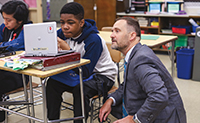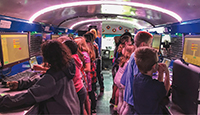When Tech and Instruction Collaborate
May 01, 2020
A Maryland district builds and sustains a cohesive relationship, sharing decision making and accountability behind a major initiative

PHOTO COURTESY OF BALTIMORE COUNTY PUBLIC SCHOOLS, TOWSON, MD.
I was sitting in the windowless office of my school district’s executive director for information technology at the end of a long day of meetings. We were struggling to find agreement on how to proceed with some key aspects of a major digital conversion
that in the first year was going to cost close to $12 million for a school system that serves 115,000 students.
A critical first step in the process was to determine next steps regarding development of a systemic technology solution to
handle learner management.
My role, as executive director of innovative learning, was to ensure the voice of the classroom, the curriculum staff and the school administrator was at the center of every conversation. His role in leading information
technology was to ensure we could deliver on the security, infrastructure and access seamlessly. We had to complement each other and learn to lead together.
Those early days together in Baltimore County in 2013 were the beginning of a cohesive
relationship that has withstood three superintendents, significant changes in central-office leadership, adjustments in system priorities and altered responsibilities. Seven years later, the school system benefits from a model that highlights complementary
leadership roles in technology and instruction that ensure the delivery of high-quality support and services to students.
This Content is Exclusive to Members
AASA Member? Login to Access the Full Resource
Not a Member? Join Now | Learn More About Membership

In a large district like ours, with 115,000 students and almost 10,000 teachers, funding for instructional resources will vary. Some schools are able to purchase innovative learning technologies while others may need to allocate funds to support other
school programs or services.
To create equitable learning opportunities for all students in Baltimore County, Md., central-office funds were allocated to renovate a retired school bus into what we call a Mobile Innovation Lab. The lab houses
tools and resources for hands-on learning experiences that can be seamlessly integrated into any subject and allow students to think creatively and innovate. A resource teacher manages the lab and its programs.
The Mobile Innovation Lab
provides elementary school residencies that typically last one week and are designed to spark interest in computational thinking, programming, robotics and computer science. The learning opportunities are incorporated into the curriculum of each class.
The goal is that each school develop and offer similar learning opportunities for students long after the lab moves on to another campus.
The lab is a shining example of the collaborative planning and actions of the district’s
departments of innovative learning, information technology and transportation. In the planning stages, new technologies had to be evaluated for use in instruction. Activities were designed for each grade level that can be modified to suit the needs
of each class. A lending library and follow-up support by the resource teacher is available throughout the school year for schools unable to fund the purchase of their own materials.
The Department of Information Technology played
a crucial role in approving hardware and software for the mobile lab. During its creation, division staff designed a computer network including mobile, cellular Wi-Fi and printing capabilities. A user account was created that allows the district’s
devices to connect to the lab’s network. A sound support system is available in the lab and through a teaching station outside.
The technology and instructional divisions continue to consult as new innovations in technology are considered
for the mobile lab.
— RYAN J. IMBRIALE
Advertisement
Advertisement
Advertisement
Advertisement



